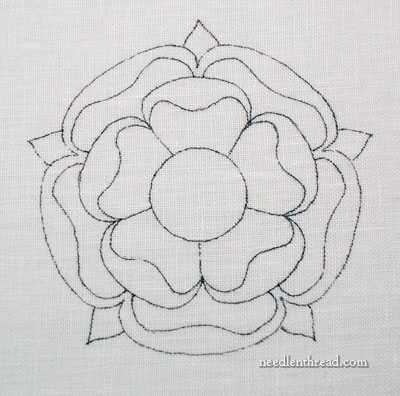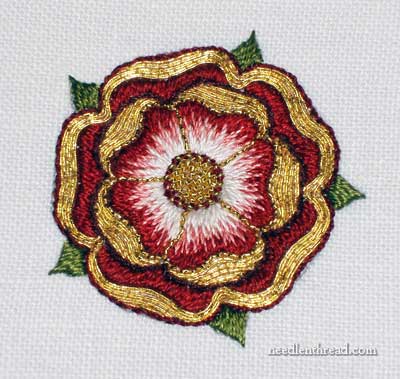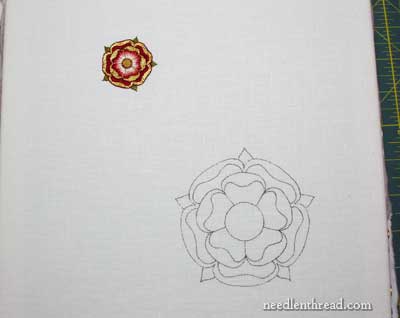Lately, I’ve taken to considering the scale of embroidery projects that I work. “Small” and “large” are relative terms when it comes to hand embroidery. Sure, a small four inch embroidery design, when lined up next to a large forty inch embroidery design, will look small, no matter what.
But there are times when a four inch embroidery design can be huge. Let me show you what I mean!

Remember the Tudor-style Rose project?

It’s always difficult to see the scale of a design in photographs, unless there’s something in the photo to establish perspective. In the two photos above, the only thing that might establish perspective, if you look closely, is the fabric. Both designs are drawn on the same linen. In the top photo featuring just the line drawing, you can’t really see the weave of the linen too well. In the second photo, you can see the weave pretty clearly.

Ah.
Better.
This newly drawn rose is ready to stitch. It’s 3.5″ in diameter, to the tips of the leaves. The previously embroidered rose is just over an inch in diameter.
Compared to the little rose, the 3.5-incher is large. To me, it seems Huge. It’s not that big, in the Scheme of All Things Big and Small, but when you start thinking about what it will take to embroider the 3.5″ rose compared to the smaller one, the project suddenly blossoms into something Large.
What points will I consider when translating my tiny rose into a larger version?
First, there’s the question of materials. If I use the same materials, the large rose will require much more of the same materials. If I change materials – if I scale them up a bit to match the size of the design, then I won’t use as much as I would, if I were using the same type of threads used in the small rose. So, for example, if a #7 tambour thread becomes a much thicker passing thread, I can cover more ground with the thicker passing thread. If the silk becomes Soie d’Alger (a stranded spun silk) instead of Soie de Paris (a finer filament silk), and if I work perhaps in two strands instead of one, I could cover more ground per stitch.
Second, there’s the question of the number of colors and shades. With much more space in the larger petals, there’s more room for gradual shading, which means that I can use more than three colors if I want.
Third, there’s the question of technique. In the small rose, none of the goldwork is padded. It is flat on the fabric, as it’s too tiny to need padding, not to mention that padding teeny spaces is a pain in the neck. I wanted the rose to be flat, anyway, so I didn’t worry about padding the goldwork. On the larger rose, the goldwork areas can definitely take padding. In fact, given their larger size, these areas are open to a whole new interpretation with the goldwork. With a larger area in which to work, can’t you imagine all different ways to fill those areas? This leads to the question of whether or not I should change the filling techniques for the goldwork areas. What do you think?
And if I pad the goldwork, there’s also the possibility of padding the silk embroidery a bit. And that can change the whole look of the rose!
See what happens when you change the size of a design? So many possibilities!
Now, it’s true. I could just proceed with the same materials, stitching the large rose in the same manner that I stitched the small rose.
But this is when hand embroidery really becomes fun! Different materials, different techniques, applied to the same design – and voilá! You see the practically infinite variety that can be had with needle & thread!
Ain’t it grand?!







Can’t you just make this your first kit for us? 😀
Excellent tutorial, Mary! This is something you don’t see/hear discussed very often. And it is SO relevant — and FUN!!
Never really gave it any thought abt size of the design, threads and cloth being used. I really need to sit down and think abt my purple flowers project. As I am limited to the standard embroidry threads where we live. Thanks once again for the Lesson.
Mary, What an immensely helpful posting with such important information you have in this posting! All too often, we amateur designers do not think to take scale into account. We think techniques, color, value, etc., but scale eludes us (or maybe I should just say “me”?). Thank you for this reminder of why I have a huge newsprint pad under my living room sofa! Noel
Am embarking on large scale (30″x45″)mixed media embroidery on waterford linen church tablecloth. Was wondering if anyone has tried
having the linen professionally pressed before preshrinking it. I’ve heard this greatly lessens the wrinkling…
Hi Mary,
I’ve been following this Tudor Rose sequence of articles with great interest. I’ve embroidered all of two of them but I love them! I would like to see some really subtle shading in the petals, and different gold treatments. I just don’t know enough about goldwork to visualize what treatments would look better in which settings. I do agree with adding the padding. On a larger piece padding gives the shape that extra dimension of height which will showcase the embroidery treatment. Can’t wait to see what you do with it.
That was only an inch wide??! The photos were all over-sized?? They didn’t look it! Or was it an inch radius and the photo is about life size?? I’m looking for a design for a 50th wedding card and was thinking of this one, but a one inch design is too small.=(
Hi, Elizabeth – The photos are close-ups, so the detail can be seen. The size is explained in the first posts in the series. The small rose is between 1 and 1.5″ – just over an inch. But don’t lose heart! The design download features four different sizes, and that’s why I’ll be scaling up the design and working a larger one…
~MC
Thanks Mary. Yes, I found the download and will have a go at a version of the 2.5″ one. I couldn’t resist measuring 2 of them and, sure enough, your original one is about 1.5″ (my ruler was a Taiwanese one and in centimetres only!!) Wow!
The thread didn’t look over-sized on the close-ups, so I’m wondering how fine it was in real life! Well, I love the design whatever and it’ll be great done in scarlet-reds and so on with some goldwork (I can put my new A-Z book to the test!) for our friends’ golden wedding card.=) I’ll track progress on my blog as ever and make sure to link back to you with the design credit.
Have a good w/e.
Do you do commission work? If so how much would you charge to do a 10-12 inch gold thread etc Tudor rose for a 15 inch throw pillow?
Beautiful work. However, if I may add to the history of this a bit and at the same time suggest changing up the pattern and colours in a completely different way, what you’ve stitched is the Lancastrian Rose.
Remember hearing about the war of the roses? Well the red rose was the badge of Lancaster. The white rosr was York, two adjining areas in the north of England. It only became the Tudor rose when it was rendered as a PINK rose, representing the ubiting of the two battling houses by a political marriage. Now doesn’t that suggest some ideas for more elabourate needleworks involving all three, some cursive writing here and there and perhaps, after a bit of heraldic research, a larger work including the coats of arms and names of the warring houses? Perhaps even a couple of quick and dirty sketches represent the castles of the two warring clans? Or prehaps a wall full of individual needleworks that tell the story?